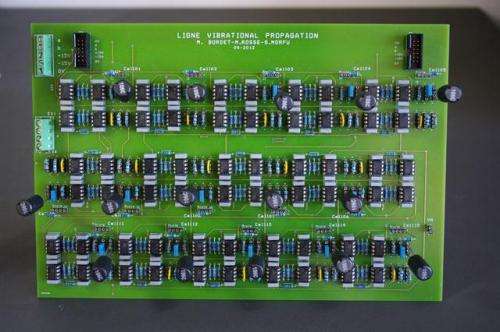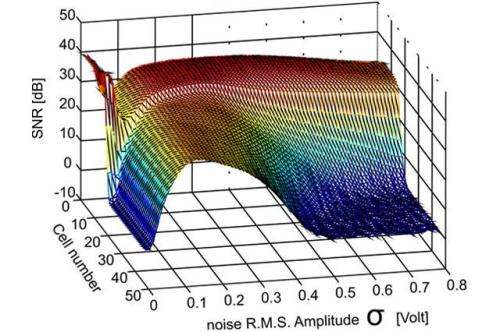Neuron circuit may enable pitch perception applications

The first FitzHugh-Nagumo neuron circuit designed to include noise and exhibit the Ghost Stochastic Resonance effect has been presented by researchers from Université de Bourgogne in France. Their circuit operates according to the exact expression of the nonlinearity required by the FitzHugh-Nagumo model of neural activity. This has allowed them to investigate the real-time effect of noise and confirm that a ghost frequency is present, a nonlinear signature that could be useful to develop pitch perception applications.
A complex process
Since neurons process information with great efficiency, the design of analogue electronic circuits that mimic neuron activity has been the subject of much research in the race to implement artificial intelligence applications. The behaviour of a neuron or assembly of neurons is nonlinear and taking this nonlinearity into account in an electronic circuit that usually obeys linear approximations could allow the development of novel and unexpected applications that overcome the limitations of classical linear processes.
Many bioinspired filtering applications have appeared as a result of the introduction of cellular neural networks (CNNs) by Chua several decades ago which use analogue circuits viewed as elementary cells coupled together to form complex networks or nonlinear lattices. There have also been many circuits developed that mimic the way in which neurons use noise to enhance their response via 'stochastic resonance'. However, the design of a whole analogue circuit mimicking the behaviour of a physical nonlinear system is still a big challenge that has to be overcome.
The power of noise

The research activities of the Université de Bourgogne team includes the development of analogue accelerators that enable the study of the behaviour of natural systems, and they also explore the properties of nonlinear systems to propose new bio- or natural-inspired processing tasks such as neurons, nonlinear physical oscillators etc. As part of their recent work in this area, they have studied Ghost Stochastic Resonance, one of several nonlinear signatures occurring in neural networks that could open up interesting and useful applications.
Ghost Stochastic Resonance arises when a nonlinear system is driven by a noisy signal with two different frequencies. The interaction of the two components and noise create a signal response with a 'ghost frequency' that is lower than the weakest input frequency. This effect has been observed previously but in electronic devices that do not obey classical neuronal models such as the FitzHugh-Nagumo equations.
The team took the original approach of designing an elementary neuron circuit with the exact expression of nonlinearity required by the FitzHugh-Nagumo model, which is cubic, in order to see if this ghost frequency would still be observed. Analysing the effect of noise in a natural system such as this by solving nonlinear stochastic differential equations with a computer is very time consuming, so using a nonlinear circuit that shares the same equation as the natural system is much more convenient as it allows the real-time analysis of the system behaviour.
In their experiments, the researchers found that they were able to control the amount of noise injected in to the system to maximise the probability of observing the ghost frequency, and that it did indeed respond with a ghost frequency of value predicted by existing theory. This phenomenon contributes to pitch perception by sensory neurons and this circuit may enable the development of new neural processing applications in this area.
New dimensions
Having developed one elementary cell, the team are now working towards developing a one dimensional lattice of coupled neuron circuits to investigate if noise could enhance the transmission of spikes in neural networks.
In the near future once the one-dimensional case has been achieved, they expect to see efforts focused on how a two-dimensional structure could be integrated and that, with the development of new circuit technology, two-dimensional analogue nonlinear networks with continuous dynamics will be likely to open up a variety of applications in image processing.
More information: "Ghost stochastic resonance in FitzHugh–Nagumo circuit" M. Bordet; S. Morfu; P. Marquié. Electronics Letters, Volume 50, Issue 12, 05 June 2014, p. 861 – 862. DOI: 10.1049/el.2014.0638 , Print ISSN 0013-5194, Online ISSN 1350-911X
Journal information: Electronics Letters
Provided by Institution of Engineering and Technology




















